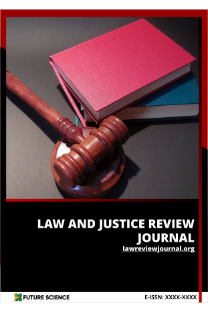THE ORIGIN OF BEYOND REASONABLE DOUBT STANDARD AND APPLICATION IN UNITED STATES CRIMINAL PROCEDURAL LAW*
Makul Şüphenin Ötesinde Standardının Kaynağı ve Birleşik Devletler Ceza Usul Hukukunda Uygulaması
___
Allen, Ronald J., A Reconceptualization of Civil Trials, Boston University Law Review, Y.1986, V.66, I.3, p.401-438.Amendments to the Constitution of the United States of America, http://www.gpo.gov/fdsys/pkg/GPO-CONAN-1992/pdf/GPO-CONAN- 1992-7.pd, access date 12.2.2013.
Aslan, Yasin, Transformation of Turkish Criminal Law from the Ottoman-Islamic Law to the Civil Law Tradition, Ankara Bar Review, Y.2009, V.2, I.2, p.92-98.
Bell v. Wolfish, 441 U.S. 520, 533 (1979), http://supreme.justia.com/cases/federal/us/441/520/case.htm, access date 13.2.2013.
Berger v. United States, 295 U.S. 78, 88 (1935). http://caselaw.lp.findlaw.com/scripts/getcase.pl?court=us&vol=295&inv ol=78, access date 10.2.2013.
Caenegem, Willian Van, Advantages and Disadvanteges of the Adversarial System in Criminal Procedings, Bond University Law Papers, 1.1.1999, p.79, http://epublications.bond.edu.au/law_pubs/224, access date 14.2.2013.
Cage v. Louisiana 498 U.S. 39 (1990), http://supreme.justia.com/cases/federal/us/498/39/, access date 14.2.2012. Chambers, Henry L., Reasonable Certainty and Reasonable Doubt, Marquette Law Review, Y.1998, V.81, I.3, p.655-704.
Cohen, Jessica N., The Reasonable Doubt Jury Instruction Giving Meaning to a Critical Concept, American Journal of Criminal Law, Y.1995, V.22, I.3, p.677-702.
Cole, George F. & Frankowski Stanislaw J. & Gertz, Marc G. (Editors), Major Criminal Justice System-A Comparative Survey, Second Edition, 1987.
Exum, Jelani Jefferson, The Essence of the Rules:A Comparison of Turkish and U.S. Criminal Procedure, http://www.johnmarshall.edu/wpcontent/uploads/2013/01/Yenisey-Comparative-Crim-ProcedureSyllabus-and-Readings.pdf, access date 9.2.2013.
Exum, Jelani Jefferson, Turkish Criminal Procedure Code (TCPC), Beta, İstanbul, 2009.
Federal Judicial Center, Pattern Criminal Jurry instructions (1988). Frase, Richard S. & Thomas Weigand, German Criminal Justice as a Guide to American Law Reform: Similar Problems, Better Solutions?, Boston College Internetional Comparative Law Review, Y.1995, V.18, I.2, p.317-360.
Freccero, Stephen P., An Introduction to the New Italian Criminal Procedure, American Journal of Criminal Law, Y.1994, V.21, N.3, p.345-384.
Gabriel, Henry D. & Barski, Katherine A., Reasonable Doubt Jury Instructions:The Supreme Court Struggles to Live by Its Principles, Journal of Civil Rights and Economic Development, Y.1995, V.11, I.1, p.73-87.
Giles v. Maryland, 386 U.S. 66, 98 (1967).
http://caselaw.lp.findlaw.com/scripts/getcase.pl?court=us&vol =386&invol=66, access date 10.2.2013. In re Winship, 397 U.S. 358, 363 (1970), http://caselaw.lp.findlaw.com/scripts/getcase.pl?court=us&vol=397 &invol=358, access date 13.2.2013.
LaFave, Wayne R. & Israel, Jerold H. & King, Nancy J., Criminal Procedure, second edition, Hornbook Series, 1999.
Langbein, John H., Comparative Criminal Procedure: Germany, West Group, 1977.
Laufer, William S., The Rhetoric of Innocence, Washington Law Review, Y.1995, V.70, I.2, p.329-422.
Mirabella, Julia Grace, Scales of Justice: Assessing Italian Criminal Procedure Through the Amanda Knox Trial, Boston University International Law Journal, http://www.bu.edu/law/central/jd/organizations/journals/international/vol ume30n1/documents/note_mirabella.pdf, access date 21.2.2013.
Mulrine, Thomas V., Reasonable Doubt: How in the World is It Defined, American University International Law Review, Y.1997, V.12, I.2, p.195-225.
Newman, Jon O., Madison Lecture: Beyond Reasonable Doubt, New York University Law Review, Y.1993, V.68, p.979-1002. Nyrop, Richard F., Turkey, a Country Study, Area Handbook Series, 1980.
OReilly, Gregory W., England Limits the Right to Silence and Moves Towards an Inquisitorial System of Justice, Journal of Criminal Science and Criminology, Y.1994, V.85, I.2, p.402-452.
Pannick, David, Jurors Who Are in Reasonable Doubt, The Times (London), Jan. 17, 1995, available in Lexis, News Library, access date 12.2.2013.
Sandoval v. California 311 U.S. 1 (1994), https://bulk.resource.org/courts.gov/c/US/511/511.US.1.92-9049.92- 8894.html, access date 14.2.2012.
Shapiro, Barbara J., Beyond Reasonable Doubt and Probable Cause, University of California Press, London England, 1991.
Shapiro, Barbara J., To a Moral Certainty: Theories of Knowledge and Anglo-American Juries 1600-1850, Hastings Law Journal, Y.1986, V.38, p.153-193.
Stacy, Tom & Dayton, Kim, Rethinking Harmless Constitutional Error, Columbia Law Review, Y.1988, V.88, I.1, p.79-143.
The trial court instruction for the jury about reasonable doubt in New York State, http://www.nycourts.gov/cji/1- General/CJI2d.Presumption.Burden.Reasonable_Doubt.pdf, access date 14.2.2013.
Victor v. Nebraska 511 U.S. 1 (1994), https://bulk.resource.org/courts.gov/c/US/511/511.US.1.92-9049.92- 8894.html, access date 14.2.2013.
Whitman, James Q., The Origins Of Reasonable Doubt, Yale Law School Faculty Scholarship Series, 3.1.2005.
- ISSN: 1309-9485
- Yayın Aralığı: 2
- Başlangıç: 2010
- Yayıncı: Türkiye Adalet Akademisi
MANDATORY TAKEOVER BIDS IN TURKEY: AN OVERVIEW OF THE NEW LEGAL REGIME
COMMON AGRICULTURAL POLICY, ITS MAJOR POLICYMAKERS AND THE MAIN CONSTRAINTS UPON THESE POLICY-MAKERS
RELIGION-STATE NEXUS IN THE MIDDLE EAST
FORENSIC SCIENCE SERVICES IN THE KINGDOM OF SAUDI ARABIA: ACHIEVEMENTS AND CHALLENGES
CHIEFS OF PUBLIC PROSECUTORS' ADMINISTRATIVE DUTIES AND AUTHORITIES IN TURKEY
CONTESTING THE RESOLUTIONS OF SHAREHOLDERS BEFORE A COURT OF LAW IN POLAND
